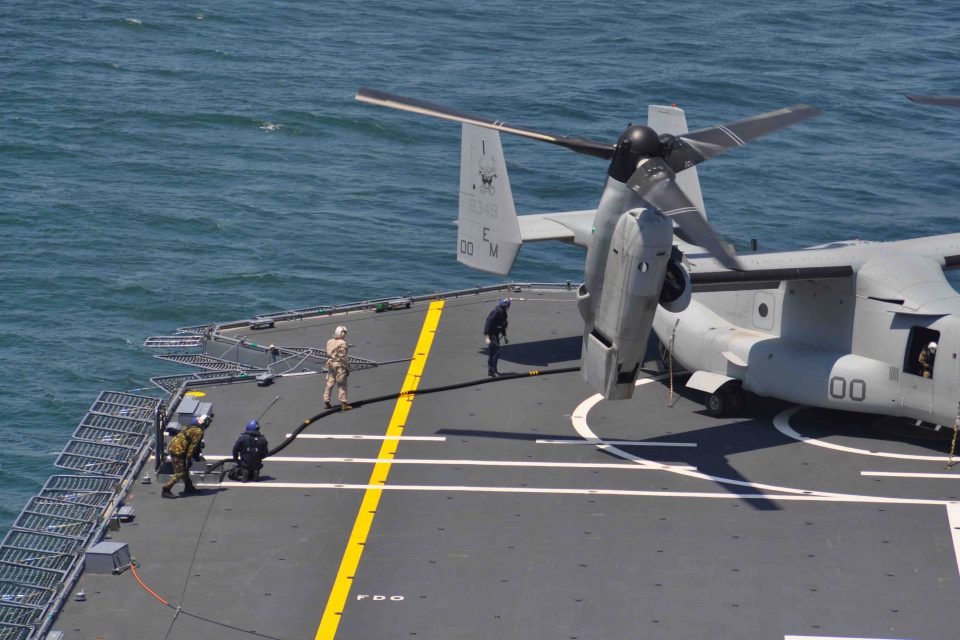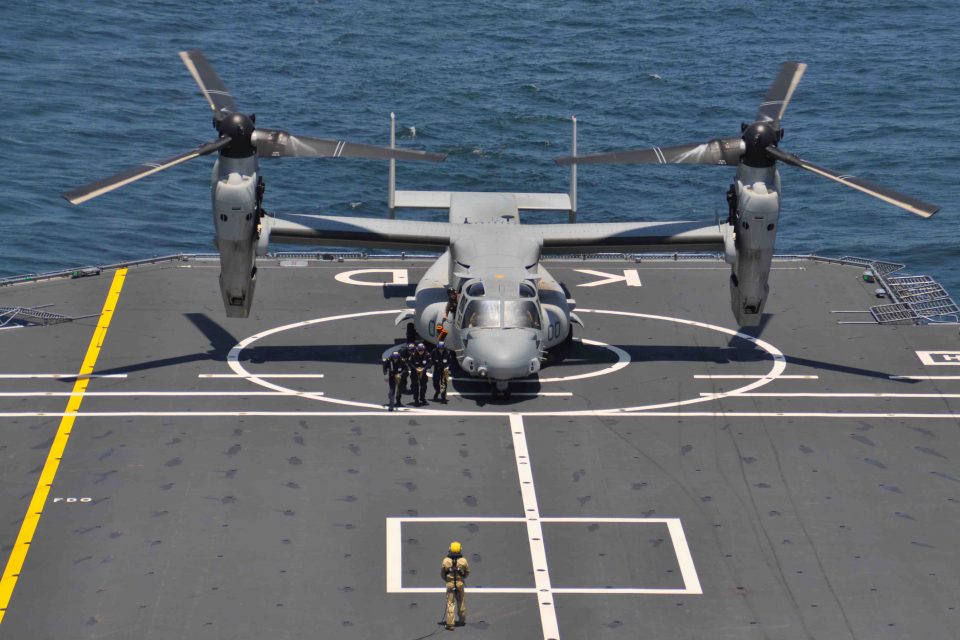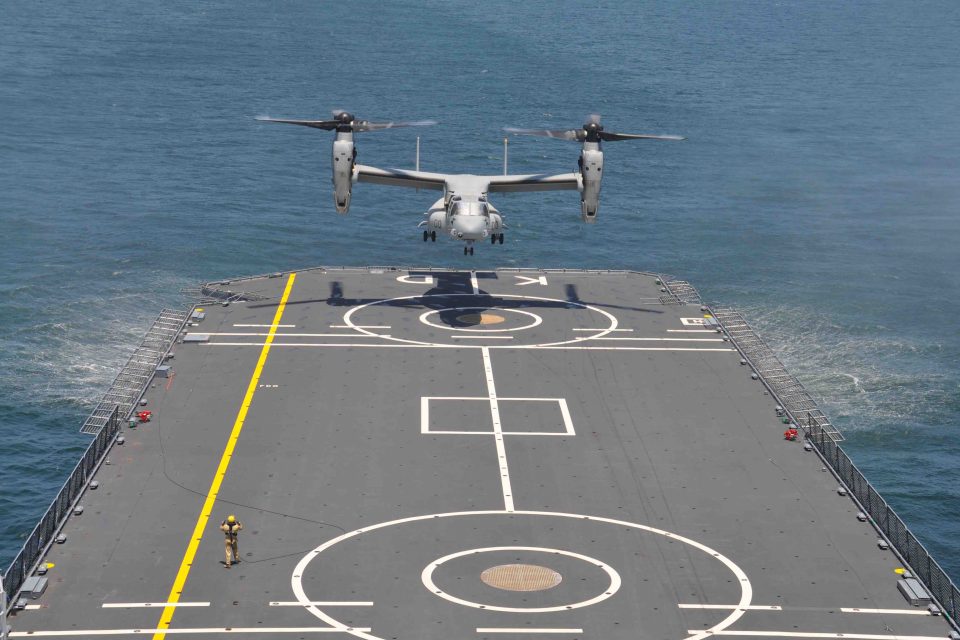2015-06-15 By Robbin Laird
The speed and range of the Osprey is a key combat enabler.
It also provides significant reach and range to connect US and allied warships into a 21st century sea base.
The capability to provide for resupply has been demonstrated many times, but the capability delivered in Operation Odyssey Dawn whereby Ospreys flew roundtrip from the USS Kearsarge to Sigonella to resupply Harriers was a clear statement of new opportunities.
As the Osprey has become a fixture of USMC and USAF global operations, the Marines have been working operations off of foreign warships as part of the process of building out an Osprey-enabled sea base, writ large.
Among others are the UK, French, Japanese, South Korean, and now Dutch warships.
https://sldinfo.com/looking-back-usmc-ospreys-and-harriers-aboard-the-hms-illustrious/
https://sldinfo.com/the-mv-22-operates-off-the-dixmude/
https://sldinfo.com/the-osprey-globally-engaged-this-time-landing-on-a-japanese-ship-in-the-apr/
During Bold Alligator 2012, the Osprey landed on a T-AKE supply ship which expanded the lily pads from which an assault force can be launched.
The Navy is looking to expand the size of the hanger aboard the T-AKE so that an Osprey can be kept in the hanger and one on deck for a total of two as needed.
https://sldinfo.com/the-osprey-and-the-usns-robert-e-peary-in-bold-alligator/
https://sldinfo.com/tak-ing-the-supply-ship-to-a-whole-other-level/
Now the two dynamics – landing on a supply ship and on a foreign warship – have been combined during training off of the East Coast of the United States with a Dutch supply ship on June 12. 2015.
In a phone interview prior to the event with the Captain of the HNLS Karl Doorman, Peter Van Den Berg, the interoperability exercise and its origins was discussed.
Where is your ship now?
Van Den Berg: We are in Norfolk undergoing demagnetization. We will perform an interoperability test later in the week with regard to landing an Osprey onboard our ship.
http://cryptome.org/eyeball/lambert-deperm/lambert-deperm.htm
Your ship is a new logistical support ship.
What are its primary missions?
Van Den Berg: it’s designed as a logistical support ship, with its primary tasking is refueling at sea.
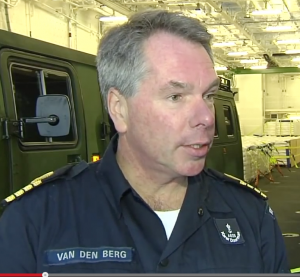
And having that capability and also this space, we also have a secondary tasking, which is strategic transport for heavy equipment.
And there’s a third task for providing the logistics from the sea base.
We can do that with the use of small landing craft or by using our very long, and large helicopter deck.
How did the test come about?
Van Den Berg: We were undergoing sea trials when we were tasked last year to support the Ebola emergency relief effort.
We had only four sea weeks on the clock when we were tasked to go to West Africa.
And while on station we witnessed the performance of the Osprey and decided that we would like to work on working with the Osprey onboard.
We requested such a test, and combined that with our visit to Norfolk for our demagnetization requirement.
Dutch naval engineers determined that we could support the weight of the Osprey and any heat generated by the engines, so we worked with the USMC to set up this test.
I should note that we only requested this test, six or seven weeks ago, and it was pushed forward by our commander general in the Netherlands with the leadership of the USMC.
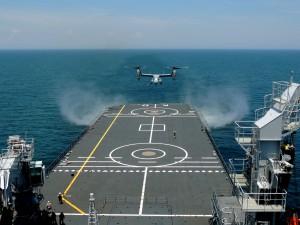
You are a supply ship with some clear capabilities to operate more traditional rotorcraft, but how do you see the potential role of the Osprey for your ship as part of a coalition seabase?
Van Den Berg: I think the Osprey in amphibious warfare is a real game changer.
The Osprey will allow us the ability to sustain our support missions because of its ability to link us for a distance and with real speed.
There is a shortage of decks; we need a connector like the Osprey able to link up those ships into an operational seabase for a coalition effort.
And from an amphibious point of view, you can operate an Osprey deep and with speed inland.
It changes the nature of the meaning of amphibious operations.
It not only expands the operational reach, but can allow ships to be further from shore and be more secure.
Addendum June 16, 2015:
I heard this morning (June 16, 2015) from Captain van den Berg who notes:
This was a first timer for the RNLNavy to have an Osprey on the deck.
The operation went very smoothly.
In all aspects and opens up the possibility to have sustainable ops on board Karel Doorman.
This is a great step forward in the already existing cooperation and strong bonds between the Marine Corpses and Navies of both countries.
And the captain provided some additional shots of the Osprey onboard his ship which are seen in the slideshow earlier in the article.
Editor’s Note: Frankly, it is hard to understand why the US Navy would buy any warship which can not land an Osprey at this point in history.
And if a more direct point needs to be made: why buy an LCS, which can only operate helicopters or an unmanned asset like Fire Scout?
And one might note that the price point of the Dutch ship is of the same magnitude as the LCS.
The price of the Dutch ship is around 400 million Euros.
Story published in late 2014:
A Dutch naval vessel on its way to aid in the fight against Ebola has taken on supplies here in Gibraltar.
The Karel Doorman is part of an international effort jointly organised by the United Nations and the European Union.
It is carrying 62 cars and 40 containers full of supplies – as well as 1,500 metric tonnes of food.
The Karel Doorman is on its way to Sierra Leone, Liberia and Guinea.
It will be spending Christmas out there, along with the Royal Navy’s RFA Argus – with one of its tasks, to bring the British crew their Christmas dinner.
About the HNLS Karel Doorman:
The Joint Logistic Support Ship (JSS) Karel Doorman is being built to ensure that the Netherlands armed forces will remain able to conduct operations outside the national boundaries in the future.
In this context, the ship is being built for 3 main tasks:
- Resupply at sea to support maritime units.
- Strategic sea transport, including debarkation and embarkation of staff and materiel if there are limited or no port facilities available
- Logistic support at sea (seabasing), in which the ship serves as the base at sea from which land operations are conducted and supported.
It is important that these tasks can be carried out in all parts of the spectrum of force, for instance during armed conflicts, warfare and civil support operations.
Specifications
Length: 204.7 meters
Beam: 30.40 meters
Height: 53 meters (including mast)
Weight of empty ship: 17,200 tonnes
Weight of load: max 10,600 tonnes
Draught: 7.6 meters
Displacement: maximum 27,800 tonnes
Propulsion: diesel-electric
Manoeuvring: 2 propellers and rudders, 2 bow propellers, 1 stern thruster
Power: 26 megawatt
Armament: Close-in weapon system (Goalkeeper) AT/FP automatic gun system 30mm, automatic .50 machine gun system, machine gun positions 7.62mm
Accommodation: 300 (crew and temporary crew)
Special features: The JSS will be equipped with a crane and lift to hoist heavy materiel.
The ship can transport about 5,000 tonnes of heavy rolling (armoured) materiel. The ship will have a hospital with 2 operating theatres. The JSS will also have landing pads for helicopters, such as Chinooks, Cougars and the NH90.
Platform
Damen Schelde Naval Shipbuilding (DSNS) is the main supplier for the JSS platform. The hull construction work and a large part of the ship’s completion will take place at Damen Shipyard Galati in Romania. The commissioning and outfitting will take place at DSNS’s facilities in Vlissingen.
Mast with integrated sensor and communication suite
Thales Nederland is the supplier of the sensor and communication mast, the so-called Integrated Sensor and Communication Suite (GSCS).
This mast is virtually identical to the ones of the navy’s patrol vessels.
The Defence Naval Sustainment and Maintenance Organisation, in cooperation with Thales, is building the integrated mast.
The HNLS Karel Doorman shares combat systems with other Dutch ships, notably the I-Mast, an innovative Thales solution for provided an integrated combat solution set.
And according to Captain Van Den Berg, because of the height of his ship the I-Mast is placed higher than on other Dutch combat ships and provides even greater area coverage than on those other ships.
https://www.thalesgroup.com/sites/default/files/asset/document/Datasheet%20IM400_DS163_10_12_HR.pdf
And who was Dutch Admiral Karel Doorman?
Dutch Admiral Karel Doorman was put in command of Allied craft on hand and headed from the East Java port of Surabaya to confront the invaders.
His fleet comprised five cruisers and ten destroyers, of mixed Dutch, British, American and Australian flags.
Light cruiser HMAS Perth had already served with distinction in several theatres of war before arriving in the East Indies, while heavy cruiser USS Houston had seen action in the region for some weeks previously, becoming nicknamed ‘the Galloping Ghost of the Java Coast’ because the Nips had reported her sunk so often.
What would be called the Battle of Java Sea began mid-afternoon on 27 February and consisted of intermittent engagements in which Allied vessels were repeatedly repulsed by Japanese naval forces, with heavy losses to the Allies.
One by one, Allied craft came to grief or had to retreat.
Admiral Doorman was a casualty, going down with his ship.
Obeying orders, Perth and Houston fled westward to Batavia (Jakarta), the capital of the Dutch East Indies.
Next morning, the Japanese dispatched the remainder of the Allied fleet, except for four American destroyers that escaped south to Australia.
This battle was the largest surface engagement since World War One.
The Allied forces had been wiped out as a naval threat to the Japanese, whose invasion of Java was delayed by a merely a day, at cost of over 2,000 Allied lives but without the loss of a single Japanese ship.



